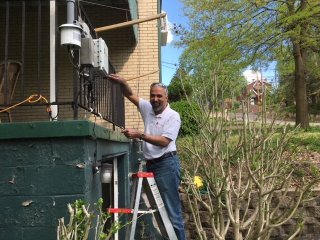EPA Research in Pennsylvania
EPA researchers are working hard to protect communities across the nation. Learn about some of the work EPA researchers are doing in Pennsylvania.
- Turning Food Waste Into Energy
- Identifying and Quantifying Ecosystem Services
- Predicting Water Quality at Beaches
- Real-time Systems for Measuring Pollutant Levels from Smoke
- River Spill Model
- Working with Communities to Monitor Air Pollution in Washington and Pennsylvania
- Researchers Explore Brownfield Revitalization’s Effects on Communities
- EPA Leads the Way on Lead Exposure Science and Risk Management
-
EPA’s EnviroAtlas Publishes Data on Three New Urban Areas, Including Philadelphia and Salt Lake City
For more EPA work, see EPA in Pennsylvania.
Turning Food Waste into Energy
Food waste is one of the largest components of our daily trash, adding up to 133 billion pounds of food at the retail and consumer levels in the United States that go uneaten. EPA is addressing this issue through the interactive Excess Food Opportunities Map, which identifies and displays information about potential generators and recipients of excess food. The map inspired Brett Reinford, a second-generation farmer in Pennsylvania, to build a digester for his family farm that turns waste into energy. Read A Winning Formula: Making Connections to Turn Food Waste into Energy.
Identifying and Quantifying Ecosystem Services
Natural resource protection and restoration goals are often tied to “ecosystem services,” the benefits people get from nature, such as fishing and other forms of subsistence and recreation. Yet the measurable data of these benefits are not often used to plan, implement, and monitor ecological restoration. Instead, the focus is usually on biological structure or ecological function, which fail to adequately communicate their potential social and economic benefits. EPA is providing technical support to state and local partners, including Pennsylvania Department of Environmental Protection, who have expressed a priority need for ways to systematically characterize and measure ecosystem services to support their efforts to identify, maintain, and restore high quality natural resources.
Predicting Water Quality at Beaches
To protect public health, beach managers need to continually assess the level of potentially harmful microbes in the water. Traditional culture-based testing methods can take 24 hours to get results – preventing same-day, proactive beach closures and leaving many recreational swimmers open to sickness or infection, or potentially close a beach needlessly and incur economic losses. ORD's Virtual Beach software offers a solution. Virtual Beach facilitates efforts to support the local economy while protecting the health of residents. Virtual Beach is used to assist in advisory issuances in the Great Lakes states and to forecast water conditions in numerous locations in Illinois, Indiana, Maryland, Michigan, Minnesota, New York, Ohio, Pennsylvania, Rhode Island, South Carolina, and Wisconsin.
Real-time Systems for Measuring Pollutant Levels from Smoke
Wildland fires pose many obstacles for air quality monitoring because of high concentrations of air pollutants, high temperatures, rugged terrain, and other challenges. EPA and partners created the Wildland Fire Sensors Challenge to develop air monitoring instruments that could handle these conditions. Read about the winners from Pittsburgh, and others, in Wildland Fire Sensors Challenge: Winners Provide Real-time Systems for Measuring Pollutant Levels from Smoke.
River Spill Model
EPA researchers developed a web-based River Spill Modeling System (RSMS) software that enables accurate 2-D modeling of spills in rivers. Water utilities can use RSMS to decide if they temporarily should close an intake, add additional treatment, or access alternative water supplies, if available. RSMS has been used by the Ohio River Valley Water Sanitation Commission (ORSANCO), an interstate commission representing eight states including PA, on spills that have occurred on the Ohio River and its tributary system for many years.
Working with Communities to Monitor Air Pollution in Washington and Pennsylvania

EPA grantees are working in cities across the country to teach local residents about how to use low-cost air pollution sensors to monitor air quality. One grantee is working with a team to teach local students how to use low-cost air pollution sensors to monitor air quality in Washington’s lower Yakima Valley. Across the country, another grantee is working with residents to monitor air quality in Pittsburgh, Pennsylvania, a city that has struggled with exposure to air pollution for many years. Read EPA Grants Fund Researchers Working with Communities to Monitor Air Pollution in Washington and Pennsylvania.
Researchers Explore Brownfield Revitalization’s Effects on Communities
Brownfields are underused properties where expansion, reuse, or redevelopment is complicated due to the presence or potential presence of a hazardous substance, pollutant, or contaminant. Cleaning up these sites offers several benefits to the community, but there are also concerns that some residents may be impacted in unforeseen ways. EPA researchers collected and analyzed neighborhood-level data in four neighborhood areas, including Philadelphia, with brownfields and explored the impacts of brownfields cleanup and reuse. Read EPA Researchers Explore Brownfield Revitalization’s Effects on Communities.
EPA Leads the Way on Lead Exposure Science and Risk Management
Lead is everywhere – the air, the soil, the water, and inside our homes. Children, whose brains are still developing, are more susceptible to a host of neurological health effects brought on by lead exposure. Three new EPA studies, one using samples from Philadelphia, on lead exposure and risk management can inform decisions to better protect children and other vulnerable groups by identifying exposure hotspots and quantifying how different sources contribute to exposure. Read EPA Leads the Way on Lead Exposure Science and Risk Management.
EPA’s EnviroAtlas Publishes Data on Three New Urban Areas, Including Philadelphia and Salt Lake City
EPA’s EnviroAtlas uses maps and data to help communities understand the relationship between nature, health, well-being, and the economy. Researchers have added fine-scale data and maps for three new urban areas to EnviroAtlas, in addition to the 24 U.S. urban areas already included. The new featured areas, Philadelphia, PA, Salt Lake City, UT, and Sonoma County, CA, collectively include over 300 cities and towns not previously covered. Read EPA’s EnviroAtlas Publishes Data on Three New Urban Areas, Including Philadelphia and Salt Lake City.
